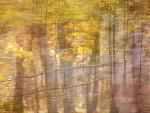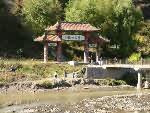- Getting around Lijiang. Dont stay in the Old Towns more than 2 days, there is nothing to do. KRISS Oct 9, 2013 05:46
- 2013 Beijing Temple Fair BENNYLAU Feb 26, 2013 03:29
- Malaysian traveling from KUL - LAX vis Shanghai PVG ZATI_DY Jan 3, 2013 20:15
The Third Korea - Antu
- Views: 4932
- |Vote: 0 0
- |Add to Favorites
- |Recommend to Friends
Autumn Tale
The cool Manchurian autumn comes swiftly after the long summer months, and is all too soon snatched away by the winter chills. The forestlands of Eastern Jilin are overcome in auburn and gold just days into the season, as if the wind itself has laid the trees with copper leaf, spreading through the woods at the rate of ocean tides. There, in the midst of great pines the colour of orange and lime, a private assembly of small communities live traditional lives in a culture that has been allowed a good deal of independence from the rest of China. Together, they are the Korean Ethnic Minority of the Yanbian Korean Semi-Autonomous Region, a people that have preserved their own language, script, art and customs as well as having successfully integrated into the modern framework of China – a people proud to be Chinese as much as they are proud to be Korean.
Yanbian is the third Korea, the people set apart from their original homeland and kept in a secluded enclave where change is gradual and daily life continues in the same fashion it has for a hundred years – a way of life that has all but disappeared from Korea itself. Korea is split in half politically, and on both sides of the border it has changed beyond recognition – in Yanbian, the old Korea can still be found, the wooden framed houses roofed in rice straw, the old kang beds with heated pipes warming the floorboards and the same technology used to heat the shin-high dining-room tables, the men in their white baggy pants and women in billowing hanboks, the same old folk dances and songs that have charmed generations of Koreans and Korea enthusiasts sung at dawn beneath the giant pines, as they have always been sung.
I awoke just before sunrise on the train that was hurtling through those woods towards Antu, the prefecture of Yanbian most famous for its major tourist attraction, the crystalline clear waters of Tianchi Lake in the crater of Changbaishan. The N169 had left Shenyang the night before, and had made its way through the industrial plains of Liaoning during the evening – the view from those same train windows could not have been more different in that morning half-light. The forest of thinly placed potbrush pines in the mists of dawn were positively enchanted, and the small bunches of homes smoked out coal like old men's pipes. Smudging like watercolours across the window glass, the leaves shone emerald and topaz in the first sun rays and sprinkled sunrise colours across the train's interior. Shenyang had been a little chilly, but this far north it was cold, and I had to pull the thin blankets from my bunk around my body as I stood watching the practically untouched countryside pass my little carriage. Yanbian's forests have for the mostpart never been felled, and the native bush is primordial in character. Tigers and black bears roam amongst those pretty trees, and as I watched the patterns of the clouds strobe past the tree trunks I could almost see them peering at me with their glassy eyes from within the dense woods.
Da Chang Jin
I arrived in Antu during something of a period of Korean fanaticism encompassing the whole of China. The most popular show on TV these days is the unthinkably long Korean Drama, Da Chang Jin, and on the windows of every Korean restaurant in Beijing hangs a picture of the show's beautiful star, Lee Youngae, hair pulled tightly back in a traditional bun, dressed in a sapphire-blue hanbok dress, put up in the hope of attracting customers to enjoy spicy Korean kimchee and Bibimbap pot mixed rice. The show's costumery is compellingly attractive, and I wondered lazily if the countryside folk of Antu prefecture would be similarly dressed in those same tight vests and wide, flowing skirts.
Korea it may be, but my fantasy of brightly-clothed Youngae look-alikes daintily tiptoeing past my train it was not. Antu railway station in the cool morning air had the crisp, certain look of a Chinese rural centre, but the Chinese characters fashioned in gold strokes over the entrance were coupled with their equivalents in Hangeul, the highly stylised Korean script.
Antu is Yanbian's major prefectural region, but the town itself is modest in scale. There is one long, central road that leads from the railway station to the middle of town, called Ming An Jie outside the station and changing its name to Weng Sheng Jie after crossing the rail lines that head further into Yanbian out towards Tumen. Ming An Jie is a quiet road, and if you have any doubt that you're in Korean China, one glance at any store or street sign will confirm it. The older generation are fluent in Chinese but literate only in Korean, and so on signs and public announcements Hangeul takes pride of place over Chinese, added as an afterthought for the benefit of the Han Chinese population who are present but outnumbered, and many of whom have learnt to speak Korean to improve communications between the two interwoven cultures.
My travelling companions and I needed breakfast, and chose a small, turquoise hut that seemed to have a mixture of Chinese and Korean morning meals on offer. Good, cheap Chinese restaurants in general all have warm steamed buns and dumplings and a hot rice porridge – this had the aforementioned and more, plates of pickled vegetable and spicy green chillies upon which to chew as you swallowed down the mouthfuls of rice and doughy bread. Some officials from the railway station were all kneeling around one small table, sectioned off in a traditional raised side-room with heated flooring and sliding doors, filling slowly with steam and the smoke from their morning cigarettes. They spoke in rolling chuggy syllables of Korean, and joked with each other in Chinese.
Not far away from the station is a small Hutong that leads to a very welcoming hotel, the Huifu Jiudian, a comfortable establishment that has no problems admitting foreigners and charges very reasonable rates. The rooms appealingly look out over one of the three rivers in Antu that come together in the town, on the other side of which is a small natural reserve that is an easy introduction to the peaceful forest ecosystem that encompasses nearly the whole of Yanbian. It was an easy decision to take a midday wander through the park.
Double Dragon Mountain Park
Yanbian is one of China's six most densely forested areas, and the ocean of trees, at that time ablaze in autumn colours, is keenly protected. Antu prefecture is an official Nature Preservation Zone on three counts, for its unique forest system and water system (containing distinctive freshwater fish species) and for its rare variety of Korean Pine tree, called the Changbai Pine. It's an attractive forest covering with trees that are naturally widely-spaced, and apart from the glorious pines you can also find Linden, Ash, Spruce, Yellow Pineapple, Walnut Catalpa, Larch and Birch, many of which are also specific to this region. Koreans roam the woods for its rare medicinal herbs and edible mushrooms, fruits and honeys, passing squirrels and otters and badgers by the way, ever watchful for forest beasts, lynx and leopard, tiger and bear.
The park across from the Huifu hotel is just a small grove of the natural wood, but makes for a pleasant stroll amongst the trees, and is lined with easy walkways and the occasional traditional Chinese pagoda looking out over Antu township.
We wandered along the river bank, decorated with street lanterns in the shape of great red Chinese knots, and crossed the bridge over the river. On the map it's called the Buerhatong River, but the locals we spoke to referred to it as Qingliang He, a name that refers to its clarity and the purity of the water. Old Korean women were doing their washing along the bank on the park side, and carrying the baskets of clothes back across the bridge, balancing the baskets on their heads in traditional Korean fashion.
Climbing the slopes of Er Long Shan park was a delight. The winding dirt paths passed beneath trees with lemon yellow and crimson leaves, red dragonflies and copper ladybugs flew up amongst the branches and down across the straw-coloured grasses. Through the trees, the farmlands of Antu were clearly visible, small old homes with wooden verandas in line alongside broad fields, orchards and vineyards, small cleared plots of land at the forest edge. Antu itself was an assortment of politely angled roofs, small chimneys and brick walls, the unmistakeable pastel shade window frames you can see all over Dongbei opening onto small alleyways.
Night in Antu had to be celebrated by a real Korean feast. Just down from the railway station is a distinctively decorated Korean restaurant serving all the Korean Chinese favourites, bright red kimchee and tofu broth, hot potato cakes, mixed spicy vegetables and of course, Korean barbeque. I sat happily over my kimchee and cool iceberg Yanbian beer, watching with great discomfort as my travelmates partook of that most horrific hallmark of Korean cuisine – dog meat hotpot. On the wall behind them hung a large poster of Lee Youngae, smiling approvingly.






 Copyright © 1998-2025 All rights reserved.
Copyright © 1998-2025 All rights reserved.
1.
Nov 19, 2005 04:00 Reply
PINETREE said:
A well-written article, Mishen.
Many thanks for it.